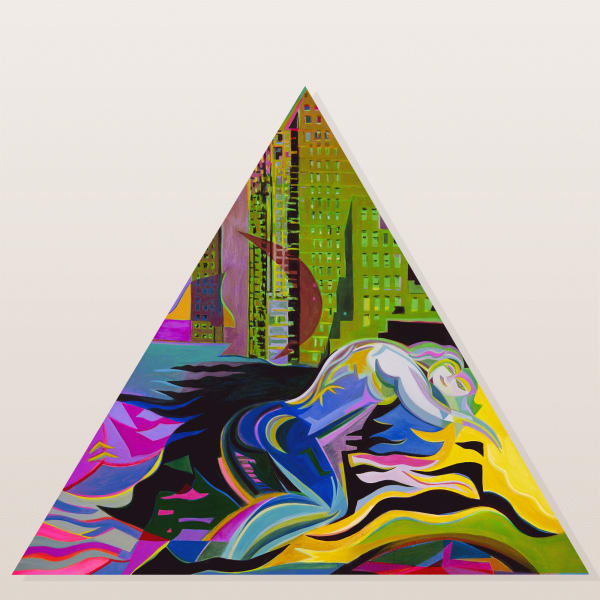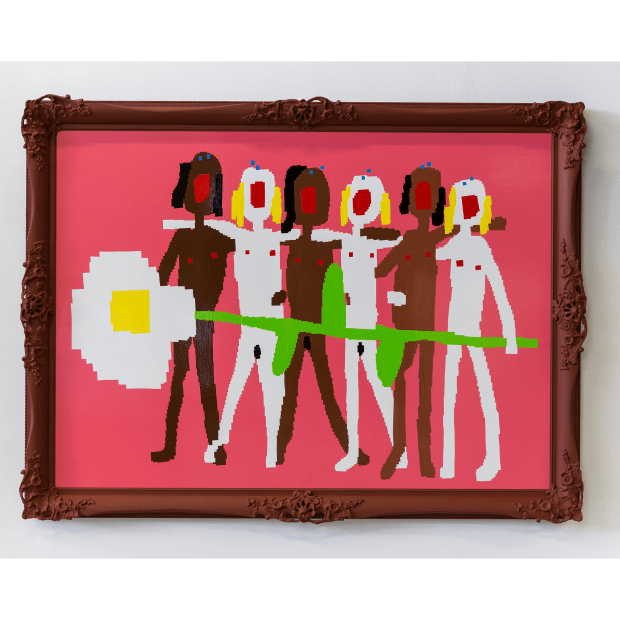-

-
Dio Horia Gallery is excited to present 'After Hope', a group exhibition based on the notion of hope. Drawing parallels with the uncertain period of the 1930s and the 1940s, the group show focuses on the conditions shaping the present, from loneliness and environmental pollution, to capitalism. The curatorial is structured along four lines: the marginalized future; the concept of human agency; survival strategies; and human emotions. These directions do not unfold as defined sectors. Rather, multidisciplinary works on canvas, ceramics and NFTs are kneaded into one environment.
Participating artists:
Chris Akordalitis, Pablo Benzo, Javier Calleja, Mira Dancy, Maja Djordjevic, Hulda Guzmán, Elias Kafouros, Katelyn Ledford, Rhys Lee, Iliodora Margellos, Tatiana Zagari (Pottato).
-

-
With a looming uncertainty lying ahead of us, Djordjevic’s After Hope, employing her distinct technique that mixes technology with child-like innocence, at first glance promotes female empowerment, inclusiveness, solidarity and optimism, though it may also convey a latent scream, communicating the PTSD of the darkest occasions this generation has encountered so far. Here, adapting to an unstable scenery that resembles Zagari’s (Pottato) ceramic works, emotions are quite complex, their expression varies and may be hard to describe or even recognize, requiring cognitive processing, while they are made up of a creative mix of multiple sentiments, often approaching trauma in intriguing ways, as does Margellos’ Study for I try to find you so I make you 2.
What is more, reevaluating coping mechanisms in this scheme, the need emerges to establish a set of new strategic choices that may provide the best options for survival, growth, and return to the hostile environment ahead. These new survival strategies, in Akordalitis’ Together, Home alone with my plants and lamps, and Picnic along the river, as well as in Guzmán’s Channeling and The Goddaughters, could result in an escapist perspective, where peace of mind is accomplished through contact with nature or pets, overall savoring immaterial goods and steadily dismantling capitalism.
Despite the intense anxiety and deep-rooted fear of this period, as reflected in Calleja’s What?, Lee’s grotesque, dream-like studies on The fight by James Ensor, commenting on war and pandemic-triggered hostility, or Kafouros’ Climate Chance, employing corporate liability, rivalry and aggressiveness, there is still the ability to make choices and to impose those choices on the world. As individual agency involves individual choices and the capacity to influence the respective life conditions and chances, Dancy’s Yellow Harbor // Siren invites viewers to a ceremonial feast, celebrating the beauty, sensuality and animalistic nature of her combative and liberated figures, setting a striking example in self-reliance and resilience. At the same time, Benzo’s work appears preoccupied with human interaction, reduced to the aesthetically pleasing relationships of its geometric angles and shapes, further emphasized through color; while Ledford strikes as debating the power of (artistic) play in this particular context.
-
Maja Djordjevic, Hope, 2022
-
Tatiana Zagari (Pottato), Visual activism NO3
-
-

AFTER HOPE | GROUP EXHIBITION: PARTICIPATING ARTISTS: CHRIS AKORDALITIS, PABLO BENZO, JAVIER CALLEJA, MIRA DANCY, MAJA DJORDJEVIC, HULDA GUZMÁN, ELIAS KAFOUROS, KATELYN LEDFORD, RHYS LEE, ILIODORA MARGELLOS, TATIANA ZAGARI (POTTATO)
Past viewing_room











